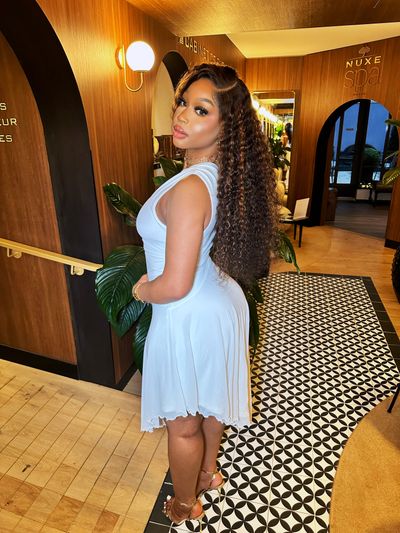Step-by-Step Guide to Installing a 4x4 Lace Closure Wig

A 4x4 lace closure wig offers a seamless and natural-looking hair transformation. This hairpiece features a 4x4-inch lace closure at the front, providing a realistic hairline and versatile styling options. Understanding the installation process is crucial for achieving a flawless look. Proper installation ensures that the wig blends well with your natural hair, enhancing the overall appearance.
Luvmeforyou provides expert guidance on installing closure wig types. This guide aims to educate you on the step-by-step process, making it easier for beginners to achieve a professional finish. Knowing the difference in wig closure vs frontal can help you make an informed choice for your styling needs.
Understanding 4x4 Lace Closure Wigs
What is a 4x4 Lace Closure?
Definition and Description
A 4x4 lace closure wig features a lace piece measuring 4 inches by 4 inches. This lace piece sits at the top or front of the wig. It provides a natural-looking hairline. The lace closure mimics the scalp, making the hair appear as if it grows directly from the head. This small yet powerful hairpiece offers various parting options. You can part the hair in the middle, sideways, or in three different ways.
Key Features
Natural Appearance: The lace closure blends seamlessly with natural hair.
Versatile Parting: Offers multiple parting styles for different looks.
Easy Installation: Effortless to install, saving time and effort.
Styling Options: You can dye, straighten, bleach, and restyle the wig.
Adjustable Fit: Comes with an adjustable band and combs for secure placement.
Benefits of a 4x4 Lace Closure
Natural Look
A 4x4 lace closure wig provides a natural look. The lace mimics the scalp, making the hair appear as if it grows naturally. This feature enhances the overall appearance. The wig blends well with natural hair, creating a flawless finish.
Versatility
The 4x4 lace closure wig offers versatility in styling. You can experiment with different parting styles. The wig allows for middle, side, and three-way parts. You can also dye, bleach, and restyle the wig to match your desired look. This flexibility makes the wig suitable for various occasions.
Protective Style
A 4x4 lace closure wig serves as a protective style. It covers the natural hair, shielding it from environmental damage. The wig reduces the need for excessive heat styling on natural hair. This protection helps maintain the health and integrity of your natural hair.
Preparing for Installation
Gathering Necessary Tools and Materials
Proper preparation ensures a smooth installation process. Gather the following tools and materials:
Wig Cap
A wig cap creates a barrier between the wig and natural hair. Choose a cap that matches your skin tone. This helps the wig look more natural. Fulton, a wig installation expert, recommends using a cap that stretches over the head without too much tension. Ensure the cap covers all hair. Use the four-finger rule to place the cap correctly. Place the pinky finger at the top of the eyebrow and count four fingers up. The cap should stop where the pointer finger ends.
Adhesive or Glue
Adhesive secures the lace closure to the scalp. Johnson, a wig styling expert, suggests using products like Got2B Glued Blasting Freeze Spray. This product provides a strong hold. Make sure to have light styling products on hand. These products help style the wig as desired.
Scissors and Comb
Scissors trim the lace and adjust the wig. A comb helps in parting and styling the wig. A rattail comb works best for precise parting. Keep these tools handy during the installation process.
Prepping Your Natural Hair
Preparing natural hair is crucial for a seamless wig installation. Follow these steps:
Cleaning and Conditioning
Start with clean and conditioned hair. Wash the hair thoroughly. Use a gentle shampoo and conditioner. Clean hair provides a better base for the wig. Conditioning keeps the hair moisturized and healthy.
Braiding or Cornrowing
Secure the natural hair by braiding or cornrowing. Fulton explains that braiding, twisting, or ponytailing the hair works well. This step ensures the wig sits flat on the head. Properly secured hair prevents lumps and bumps under the wig. After securing the hair, put on the wig cap.
By following these steps, you ensure a smooth and natural-looking installation. Luvmeforyou provides expert guidance to help achieve a flawless finish.
Step-by-Step Installation Process

Securing the Wig Cap
Choosing the Right Cap
Select a wig cap that matches your skin tone. This choice ensures a natural look. Experts recommend using a cap that stretches comfortably over your head. Avoid caps that create too much tension. A snug fit helps the closure wig lay flat and secure.
Proper Placement
Place the wig cap correctly for a seamless base. Use the four-finger rule to position the cap. Place your pinky finger at the top of your eyebrow. Count four fingers up. The cap should stop where your pointer finger ends. Ensure the cap covers all your hair. This step prevents any natural hair from peeking through.
Applying the 4x4 Lace Closure
Positioning the Closure
Position the 4x4 lace closure at the front of your head. Align the closure with your natural hairline. Make sure the lace sits flat against your scalp. Adjust the closure until it looks even and natural. This step sets the foundation for a flawless install.
Securing with Adhesive
Use adhesive to secure the lace closure. Experts suggest products like Got2B Glued Blasting Freeze Spray. Apply the adhesive along your hairline. Press the lace into the adhesive gently. Hold the lace in place until the adhesive dries. This process ensures a strong hold and a natural appearance.
Blending and Styling
Cutting the Lace
Trim the excess lace carefully. Use sharp scissors for a clean cut. Follow the natural curve of your hairline. Avoid cutting too close to the hair. Leave a small margin to blend with your skin. This step helps achieve a seamless look.
Blending with Natural Hair
Blend the lace closure with your natural hair. Use a comb to part the hair as desired. Style the hair to cover any visible lace edges. Experts recommend light styling products for a natural finish. This step enhances the overall appearance of the closure wig.
Final Styling Tips
Style the wig to match your desired look. You can straighten, curl, or dye the hair. Use heat protectant products to avoid damage. Experiment with different parting styles. This flexibility allows you to customize your look. Proper styling completes the installation process.
Maintenance and Care Tips

Daily Care Routine
Brushing and Detangling
Brush the wig daily to maintain its appearance. Use a wide-tooth comb or a wig brush. Start from the ends and work your way up to the roots. This method prevents tangling and breakage. Always handle the wig gently to avoid damaging the lace and hair strands.
Avoiding Heat Damage
Minimize the use of heat styling tools. Excessive heat can damage the wig fibers. If you must use heat, apply a heat protectant spray first. Set the tools to a low or medium temperature. Avoid using heat on the lace area to prevent weakening the adhesive.
Washing and Conditioning
Recommended Products
Choose sulfate-free shampoos and conditioners. Sulfates can strip the wig of its natural oils. Look for products specifically designed for wigs or human hair extensions. These products help maintain the wig's softness and shine.
Washing Frequency
Wash the wig every 10-15 wears. Over-washing can lead to dryness and tangling. Fill a basin with lukewarm water and add a small amount of shampoo. Gently swish the wig in the water. Rinse thoroughly and apply conditioner. Let the conditioner sit for a few minutes before rinsing. Pat the wig dry with a towel and let it air dry on a wig stand.
Long-term Maintenance
Storage Tips
Store the wig properly when not in use. Use a wig stand or mannequin head to maintain its shape. Keep the wig in a cool, dry place away from direct sunlight. Cover the wig with a silk or satin scarf to protect it from dust and friction.
Regular Check-ups
Inspect the wig regularly for signs of wear and tear. Check the lace for any damage or fraying. Look for any loose or shedding hair. Address any issues promptly to extend the wig's lifespan. Proper care ensures that the wig remains in excellent condition for a longer period.
Chandra Hair emphasizes the importance of proper wig care: "Every time you use a wig, thoroughly clean your wigs to shape a healthy look and help lengthen its life."
By following these maintenance and care tips, you can enjoy a fabulous and attractive look with your 4x4 lace closure wig for an extended period.
Recap the key points of the installation process:
Gather tools and materials: Wig cap, adhesive, scissors, and comb.
Prep your natural hair: Clean, condition, and braid or cornrow.
Secure the wig cap: Choose the right cap and place it correctly.
Apply the 4x4 lace closure: Position and secure with adhesive.
Blend and style: Cut the lace, blend with natural hair, and style.
Reinforce the benefits of using a 4x4 lace closure wig:
Natural look: Mimics the scalp for a seamless appearance.
Versatility: Offers various parting styles and can be dyed or styled.
Protective style: Shields natural hair from damage.
Encourage readers to try the installation themselves and explore related products. Achieving a flawless look is possible with patience and attention to detail. Embrace the versatility and ease of a 4x4 lace closure wig for stunning hairstyles.






















